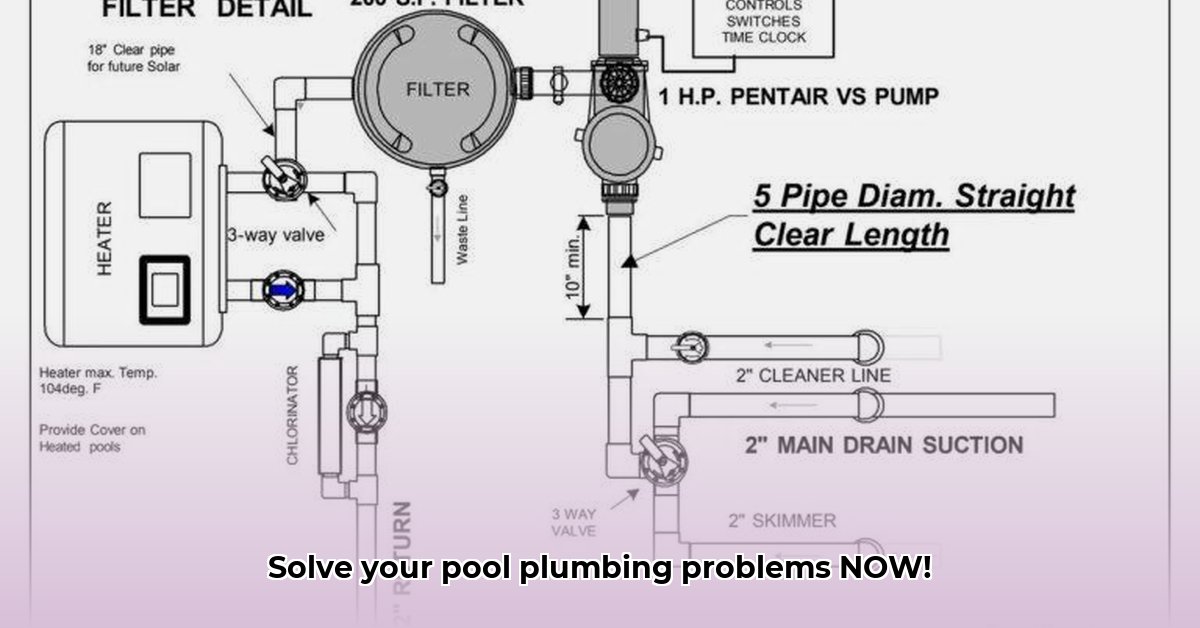
Understanding Your Pool's Plumbing System
Understanding your pool's plumbing is crucial for maintaining sparkling water and avoiding costly repairs. This guide will help you decipher pool equipment diagrams, troubleshoot common issues, and perform basic maintenance. Think of your pool's plumbing as its circulatory system—a network of pipes, valves, and equipment working together to keep the water clean and flowing. Did you know that a properly maintained system can save you up to 75% on energy costs over its lifetime?
Core Pool Equipment Components
Several key components form the foundation of your pool's plumbing. Let's explore them with simplified diagrams:
1. Pump: The powerhouse that circulates water through the entire system. (Think of it as your pool's heart.)
➡️ (Pump) ➡️
2. Filter: Removes debris and impurities from the water. (Like your pool's kidneys.)
(Pump) ➡️ (Filter) ➡️
3. Skimmer: Collects surface debris such as leaves and insects. (Your pool's first line of defense.)
(Skimmer) ➡️ (Pump)
4. Return Lines: Deliver clean, filtered water back to the pool. (The arteries of your pool's circulatory system.)
➡️ (Return)
5. Valves: Control and direct the flow of water. (Traffic controllers of the system.)
(Valve) ⬊ (Pipe)
Decoding Pool Equipment Diagrams: Various System Configurations
Pool equipment diagrams vary in complexity, much like maps ranging from simple street maps to detailed topographic surveys. Understanding these variations is crucial for troubleshooting and maintenance.
1. Basic Pool System: This shows the essential components – pump, filter, skimmer, and return lines. It's the simplest representation, ideal for grasping the fundamental water flow.
2. Spa-Integrated System: This diagram includes the plumbing for a connected spa, illustrating water flow between the pool and spa. You'll see additional piping and valves controlling the water flow between the two.
3. Water Feature System: If you have a waterfall or fountain, its plumbing will be depicted here. This includes separate lines and potentially additional pumps to operate the feature.
Troubleshooting Common Pool Plumbing Issues
Is your pool's circulation weak? Your pool equipment diagram is your best troubleshooting tool. Here's a step-by-step approach:
Check the Pump: Listen for unusual noises. Is it running? A malfunctioning pump can significantly reduce water flow.
Inspect the Filter: A clogged filter restricts water flow. Does it need cleaning or backwashing? Cleaning or replacing your filter is a crucial part of routine pool maintenance.
Examine the Valves: Ensure all valves are open and functioning correctly. Your diagram will show their location and impact on water flow.
Search for Leaks: Systematically check all pipes and connections, especially areas highlighted on your diagram. Even small leaks can cause significant problems.
Maintaining Your Pool's Plumbing System
Regular maintenance is akin to preventative medicine for your pool. A little care prevents costly repairs. Your pool equipment diagram serves as your maintenance guide, indicating which components need attention and how often. Regularly inspect your equipment. Clean your filter according to manufacturer instructions. Lubricate moving parts on your pump to extend its lifespan.
Pool Safety: Main Drain Entrapment
Your pool equipment diagram should clearly show the location of your main drain. Main drain entrapment is a serious hazard. Understanding your system’s layout is vital for safety. Modern pools incorporate safety features to mitigate this risk, but regular inspection of the main drain grate's functionality is crucial. Never underestimate the importance of safety around your pool.
Advanced Concepts: Energy Efficiency and Pump Selection
Optimizing your pool’s pump and filter system can lead to significant energy savings (up to 75%). Variable-speed pumps offer superior energy efficiency compared to single-speed models. Remember, proper pump sizing is crucial – an oversized pump wastes energy, while an undersized one struggles and can damage equipment. Regular maintenance and smart control systems further enhance efficiency. Consult with a pool professional to determine the optimal pump and filter for your pool's specific needs. Remember, a cost-benefit analysis is vital before undertaking any upgrades.